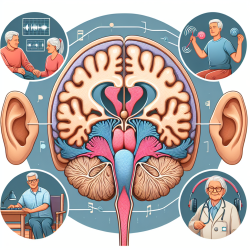Introduction
In the realm of special education and therapeutic services, understanding the neural mechanisms underlying auditory spatial processing can significantly enhance the effectiveness of interventions. The research titled "Intra- and interhemispheric white matter tract associations with auditory spatial processing: Distinct normative and aging effects" provides invaluable insights into how white matter microstructures, specifically the arcuate fasciculus and corpus callosum, impact auditory spatial processing across different age groups.
Understanding White Matter's Role
The study highlights the importance of the arcuate fasciculus and corpus callosum in auditory spatial processing. These white matter tracts are crucial for integrating auditory spatial information, which is essential for localizing and attending to sounds in complex auditory environments, such as classrooms or therapy sessions. The research found that higher fractional anisotropy (FA) in these tracts correlates with better auditory spatial processing abilities in both younger and older adults.
Implications for Practitioners
For practitioners providing online therapy services like those at TinyEYE, integrating these findings into practice can lead to more targeted and effective interventions. Here are some strategies to consider:
- Assessment and Monitoring: Regularly assess the auditory spatial processing abilities of clients using tasks that require sound localization and attention. Monitoring changes over time can help tailor interventions to individual needs.
- Targeted Exercises: Develop exercises that specifically enhance interhemispheric and intrahemispheric processing. This could involve tasks that require clients to focus on sounds coming from different directions or to distinguish between competing auditory signals.
- Collaborative Research: Encourage collaboration with neuroscientists to further explore how changes in white matter microstructure can be influenced by therapeutic interventions. This could lead to the development of new techniques that directly target these neural pathways.
Encouraging Further Research
While the study provides a foundational understanding, there is a need for further research to explore how therapeutic interventions can modify white matter microstructure. Practitioners are encouraged to participate in or initiate studies that examine the impact of specific therapies on the arcuate fasciculus and corpus callosum. Such research could uncover new methods to enhance auditory spatial processing, particularly in aging populations.
Conclusion
The ability to process auditory spatial information is critical for effective communication in noisy environments, a common challenge in educational and therapeutic settings. By understanding and leveraging the insights from this research, practitioners can improve their interventions, ultimately leading to better outcomes for their clients. To read the original research paper, please follow this link: Intra- and interhemispheric white matter tract associations with auditory spatial processing: Distinct normative and aging effects.










